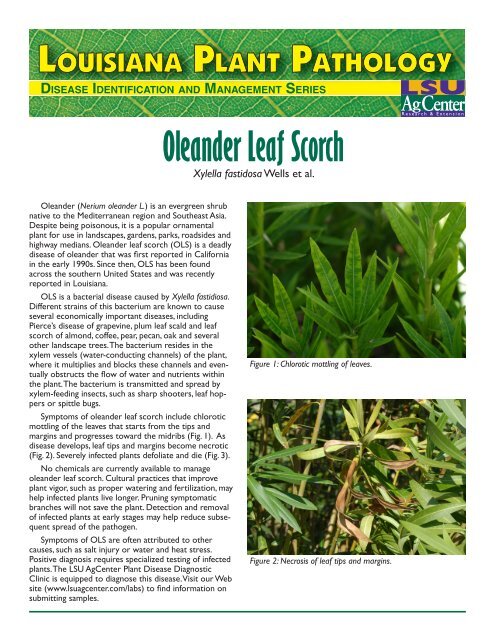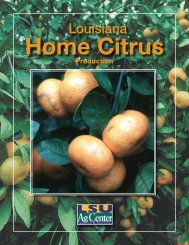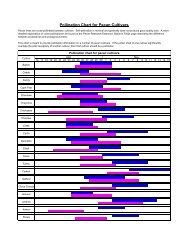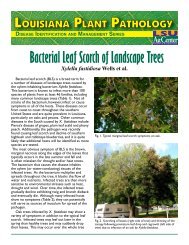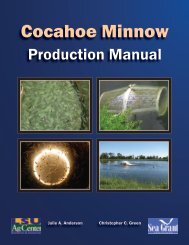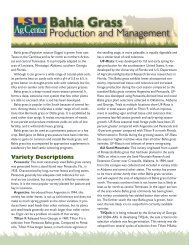pub3144 Oleander Leaf Scorch HIGH RES.pdf - The LSU AgCenter
pub3144 Oleander Leaf Scorch HIGH RES.pdf - The LSU AgCenter
pub3144 Oleander Leaf Scorch HIGH RES.pdf - The LSU AgCenter
You also want an ePaper? Increase the reach of your titles
YUMPU automatically turns print PDFs into web optimized ePapers that Google loves.
<strong>Oleander</strong> (Nerium oleander L.) is an evergreen shrub<br />
native to the Mediterranean region and Southeast Asia.<br />
Despite being poisonous, it is a popular ornamental<br />
plant for use in landscapes, gardens, parks, roadsides and<br />
highway medians. <strong>Oleander</strong> leaf scorch (OLS) is a deadly<br />
disease of oleander that was first reported in California<br />
in the early 1990s. Since then, OLS has been found<br />
across the southern United States and was recently<br />
reported in Louisiana.<br />
OLS is a bacterial disease caused by Xylella fastidiosa.<br />
Different strains of this bacterium are known to cause<br />
several economically important diseases, including<br />
Pierce’s disease of grapevine, plum leaf scald and leaf<br />
scorch of almond, coffee, pear, pecan, oak and several<br />
other landscape trees. <strong>The</strong> bacterium resides in the<br />
xylem vessels (water-conducting channels) of the plant,<br />
where it multiplies and blocks these channels and eventually<br />
obstructs the flow of water and nutrients within<br />
the plant. <strong>The</strong> bacterium is transmitted and spread by<br />
xylem-feeding insects, such as sharp shooters, leaf hoppers<br />
or spittle bugs.<br />
Symptoms of oleander leaf scorch include chlorotic<br />
mottling of the leaves that starts from the tips and<br />
margins and progresses toward the midribs (Fig. 1). As<br />
disease develops, leaf tips and margins become necrotic<br />
(Fig. 2). Severely infected plants defoliate and die (Fig. 3).<br />
No chemicals are currently available to manage<br />
oleander leaf scorch. Cultural practices that improve<br />
plant vigor, such as proper watering and fertilization, may<br />
help infected plants live longer. Pruning symptomatic<br />
branches will not save the plant. Detection and removal<br />
of infected plants at early stages may help reduce subsequent<br />
spread of the pathogen.<br />
Symptoms of OLS are often attributed to other<br />
causes, such as salt injury or water and heat stress.<br />
Positive diagnosis requires specialized testing of infected<br />
plants. <strong>The</strong> <strong>LSU</strong> <strong>AgCenter</strong> Plant Disease Diagnostic<br />
Clinic is equipped to diagnose this disease. Visit our Web<br />
site (www.lsuagcenter.com/labs) to find information on<br />
submitting samples.<br />
<strong>Oleander</strong> <strong>Leaf</strong> <strong>Scorch</strong><br />
Xylella fastidosa Wells et al.<br />
Figure 1: Chlorotic mottling of leaves.<br />
Figure 2: Necrosis of leaf tips and margins.
Figure 3: Severely infected oleander plant.<br />
Author and Photo Credits<br />
Dr. Raghuwinder Singh<br />
Dr. Don Ferrin<br />
Department of Plant Pathology and<br />
Crop Physiology<br />
Visit our Web site: www.lsuagcenter.com<br />
Louisiana State University Agricultural Center<br />
William B. Richardson, Chancellor<br />
Louisiana Agricultural Experiment Station<br />
David J. Boethel, Vice Chancellor and Director<br />
Louisiana Cooperative Extension Service<br />
Paul D. Coreil, Vice Chancellor and Director<br />
Pub. 3144 (online only) 2/10<br />
Issued in furtherance of Cooperative Extension work, Acts of Congress of May 8 and June 30, 1914, in<br />
cooperation with the United States Department of Agriculture. <strong>The</strong> Louisiana Cooperative Extension<br />
Service provides equal opportunities in programs and employment.


